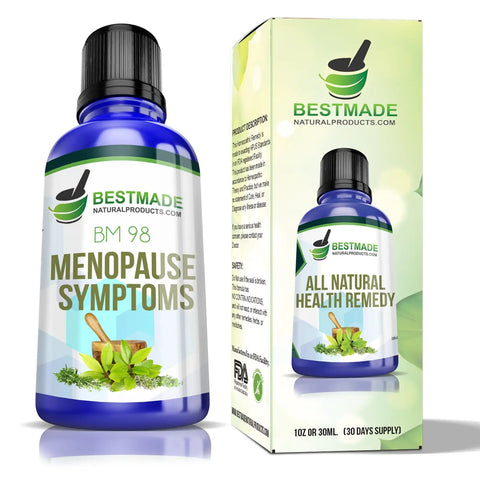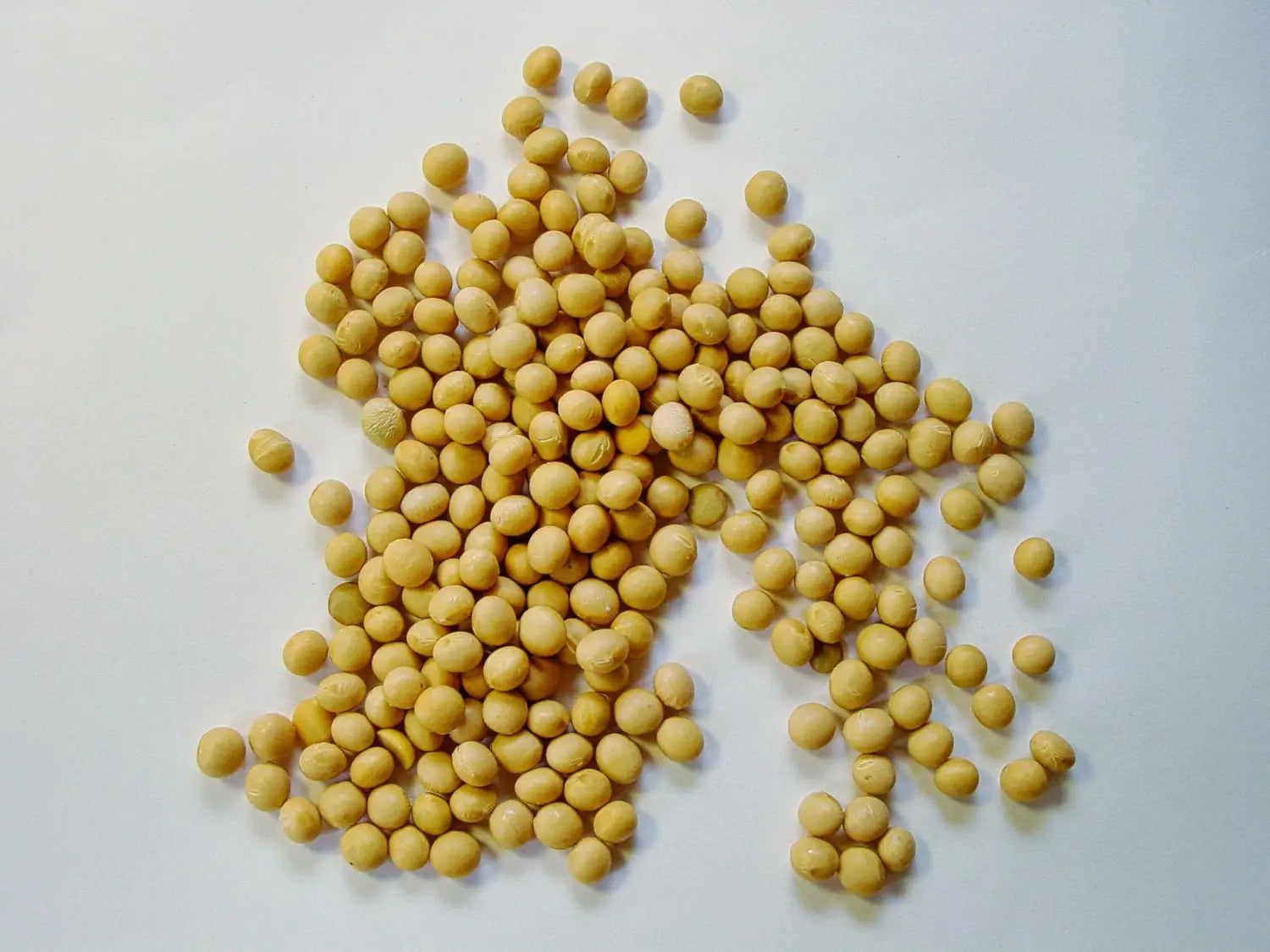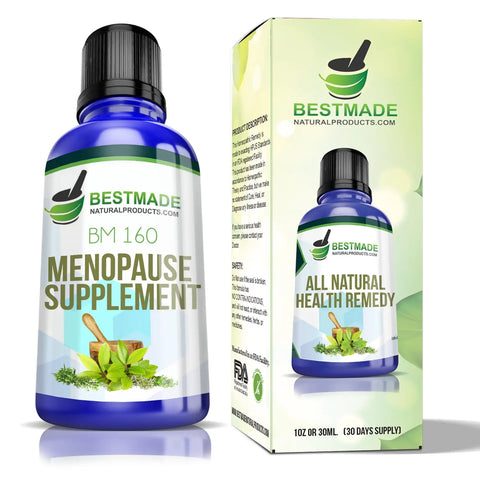
MENOPAUSE AND PERIMENOPAUSE: SYMPTOMS & NATURAL REMEDY FOR IT
What is it and how to deal with it?
Menopause officially marks the end of female reproduction and occurs when you stop menstruating.
There are actually different stages within menopause that are important to recognize and understand. Perimenopause simply means “around menopause” and it is the transitional phase that happens right before menopause Although they’re both parts of the same overall life transition, menopause and perimenopause have different symptoms and treatment options.

BM98 supports your body through menopause or pre-menopause. Helpful for hot flushes, loss of vaginal lubrication, mood changes, night sweats, urine leakage, urinary tract problems, changes in menstrual cycles, increased pre-menstrual syndrome, mood changes, fluctuation in sexual desire, forget-fullness, fatigue, insomnia, decreasing fertility, and skin changes.
Premenopause vs. Perimenopause
Sometimes people use these terms interchangeably but premenopause and perimenopause are simply not the same thing. Premenopause means before you have any symptoms of perimenopause or menopause You still have periods — whether they’re regular or irregular — and are considered to be in your reproductive years. Your hormones might be shifting or changing, but it is unlikely that you will see any changes in your body.
Noticeable changes will occur during perimenopause, you’ll start to experience some of the symptoms of menopause, such as...
- changes in your period cycle
- hot flashes
- sleep disturbances
- mood swings
Perimenopause happens well before you hit menopause. It's the time when the ovaries gradually begin to make less estrogen. for some women estrogen levels can bounce up and down causing irregular periods and other problems. Usually, perimenopause occurs in women in their 40s, for some women it can start even earlier especially if there is a family history of early menopause.
Perimenopause lasts right up until menopause, the point when the ovaries completely stop releasing eggs. In the last 1 to 2 years of perimenopause, the drop in estrogen production speeds up. By the time most women reach this stage, they are already experiencing menopause symptoms.
How Long Does Perimenopause Last?
The average length of perimenopause is about 4 years. In some cases, this stage may last only a few months, but it could continue for as long as 10 years. Perimenopause officially ends when a woman has gone 12 months without having her period.
What Are the Signs of Perimenopause?
You may not experience all of these (hopefully not), but you will likely experience at least a few….- Hot flashes
- Fatigue
- Tender breasts
- Severe pms symptoms
- Decreased libido
- Irregular periods
- Vaginal dryness; painful sex
- Urine leakage when coughing or sneezing
- Urinary urgency (an urgent need to urinate more frequently)
- Mood swings
- insomnia
Are My Perimenopausal Symptoms Normal or Something to Be Concerned About?
Irregular menstrual cycles are common and normal during perimenopause. There are a number of other medical conditions that can cause irregular bleeding. If any of the following situations apply to you, see a doctor and rule out other causes:- Very heavy periods, or periods that have blood clots.
- Abnormally long periods
- Spotting between periods.
- Sexual intercourse that causes spotting
- Irregular menstrual cycles
Causes of abnormal bleeding include hormone problems, birth control pills, pregnancy, fibroids, blood clotting problems, and in rare cases cancer.
How Is Perimenopause Diagnosed?
Doctors will use your symptoms to help them diagnose if you are perimenopausal. Hormone levels change during perimenopause so a simple blood test to check hormone levels may also help, repeating the blood work a few times may give the doctor a more complete picture due to hormone fluctuations.
Menopause: What Is It?
Menopause is the process women go through that causes their periods to end. It's a turning point, not a disease, but it can have a big impact on a woman's well-being. Although menopause can bring physical discomfort from hot flashes, night sweats, and other symptoms, it can also be the start of a new and rewarding phase of a woman's life -- and a golden opportunity to guard against major health risks like heart disease and osteoporosis.
BM160 is recommended for mood swings, sleep issues, irregular or heavy bleeding, and emotional distress.
What Causes It?
Age is the leading cause of menopause. It signals the end of a woman's childbearing years and is caused by the ovaries gradually slowing down. Some surgeries and medical treatments can also lead to menopause. These include chemotherapy, surgical removal of the ovaries (bilateral oophorectomy), and pelvic radiation therapy. Having a hysterectomy (surgical removal of the uterus) without removing the ovaries does not lead to menopause; although you will not menstruate anymore.
When Does Menopause Start?
On average, women in the U.S. are 51 when menopause naturally occurs, the National Institute on Aging says it is possible for menopause to start earlier or later. Some women will start menopause as young as 40, and a few as late as 60. Women who smoke tend to go through menopause earlier than nonsmokers. There is no way to predict the age at which menopause will start. A woman must miss her period for 12 straight months, without other obvious causes, before menopause can be confirmed. There are tests that can check your ovaries and spot a decrease in fertility.

Menopause symptoms
Throughout the menopausal transition, some subtle — and some not-so-subtle — changes in your body may take place. You might experience:- Irregular periods. As ovulation becomes more unpredictable, the length of time between periods may be longer or shorter, your flow may be light to heavy, and you may skip some periods. If you have a persistent change of seven days or more in the length of your menstrual cycle, you may be in early perimenopause. If you have a space of 60 days or more between periods, you're likely in late perimenopause.
- Hot flashes and sleep problems.(change this link to search term “insomnia” but leave text as it appears now) Hot flashes are common during perimenopause. The intensity, length and frequency vary. Sleep problems are often due to hot flashes or night sweats, but sometimes sleep becomes unpredictable even without them.
BM25 is best used for sleeplessness, Neurasthenia, mental disturbance due to worry and fear, or sleep disturbance from dreams.
- Mood swings. Mood swings, irritability or increased risk of depression may happen during perimenopause. The cause of these symptoms may be sleep disruption associated with hot flashes. Mood changes may also be caused by factors not related to the hormonal changes of perimenopause.
- Vaginal and bladder problem When estrogen levels diminish, your vaginal tissues may lose lubrication and elasticity, making intercourse painful. Low estrogen may also leave you more vulnerable to urinary or vaginal infections. Loss of tissue tone may contribute to urinary incontinence.
- Decreasing fertility. As ovulation becomes irregular, your ability to conceive decreases. However, as long as you're having periods, pregnancy is still possible. If you wish to avoid pregnancy, use birth control until you've had no periods for 12 months.
- Changes in libido. During perimenopause, sexual arousal and desire may change. But if you had satisfactory sexual intimacy before menopause, this will likely continue through perimenopause and beyond.
- Bone Loss. With declining estrogen levels, you start to lose bone more quickly than you replace it, increasing your risk of osteoporosis — a disease that causes fragile bones.
BM221 may help with bone density issues and bone function. Useful for bone density issues, including overall weak bone density, hardness, and issues of stability and function.
- Cholesterol levels Declining estrogen levels may lead to unfavorable changes in your blood cholesterol levels, including an increase in low-density lipoprotein (LDL) cholesterol — the "bad" cholesterol — which contributes to an increased risk of heart disease. At the same time, high-density lipoprotein (HDL) cholesterol — the "good" cholesterol — decreases in many women as they age, which also increases the risk of heart disease.
When to see a doctor
Some women simply put up with the uncomfortable symptoms of menopause, while others seek medical attention. Of course, some women don’t seek help because they only experience mild symptoms. The changes may be subtle at first and you may not realize that they're all connected to the same thing — rising and falling levels of estrogen and progesterone, another key female hormone.
When the symptoms of menopause interfere with your life or well-being, it is likely time to see your doctor.
Risk factors
Menopause is a normal phase in life. But it may occur earlier in some women than in others. Although not always conclusive, some evidence suggests that certain factors may make it more likely that you start perimenopause at an earlier age, including:BM55 may help with withdrawal, including tobacco cravings, burning in the stomach, bad breath, sleep disturbance, nightmares, and chilliness.
- Family history. Women with a family history of early menopause may experience early menopause themselves.
- Cancer treatment. Treatment for cancer with chemotherapy or pelvic radiation therapy has been linked to early menopause.
- Hysterectomy. A partial hysterectomy means you won’t get your period but it doesn’t remove your ovaries so they continue to produce estrogen. If one ovary is removed the other might just stop working. This type of surgery can cause a woman to go into menopause earlier than is normal. A complete hysterectomy will launch you directly into menopause.

Complications
Irregular periods are a normal part of perimenopause and rarely a reason for concern. However, if you experience any of the following situations please see your doctor.
- Extremely heavy flow, where you are required to change tampons or pads every 1 to 2 hours for a time period of longer than 2 hours
- Blood flow that lasts longer than 1 week
- Breakthrough bleeding between periods
- A menstrual cycle that is less than 21 days
These symptoms might signal a more serious health concern in your reproductive system, getting your doctor to diagnose the situation is necessary.
Treatments for perimenopause and menopause
There are both prescription and over-the-counter (OTC) treatments available for perimenopause and menopause.Estrogen
Estrogen (hormone) therapy works by normalizing estrogen levels so sudden hormonal spikes and drops don’t cause uncomfortable symptoms. Some forms of estrogen may even help reduce the risk of osteoporosis.
Estrogen is available over the counter or by prescription; it is often used in conjunction with progestin. There are a variety of ways to deliver estrogen to your body including:
- skin patches
- creams or gels
- pills
Many people use estrogen therapy to reduce the symptoms of menopause but please be aware that the use of estrogen can increase your risk for breast, uterine and ovarian cancer. This is especially true if there is a history of breast cancer in your immediate family (mother, sister, aunt)
BM14 may help your body deal with amenorrhoea, dysmenorrhoea, and cramps in the pelvic region. Useful for painful menses in young women.
Other Options
If you are suffering from a very specific concern like proper vaginal lubrication or moodiness then you might want a product that specifically addresses the concern...
- Prescription vaginal creams can alleviate dryness as well as pain from intercourse.
- Antidepressants can help with mood swings.
- The seizure medication gabapentin (Neurontin) can be an option for hot flashes.
Natural Solutions & Lifestyle Changes
Regular exercise can help improve your mood, aid in weight loss and even minimize your hot flashes. So it’s a great idea to include some form of physical activity in your day. But don’t exercise too late in the day as it can interfere with getting to sleep at night.
Insomnia can be a real issue for perimenopausal and menopausal women, try doing a relaxing activity right before bed. Night-time yoga or a warm bath might be great options. Avoid daytime naps, as this can interfere with your ability to sleep at night.
Here are a few other lifestyle changes that could help minimize symptoms...
- Don’t drink caffeinated beverages in the evening
- Limit your alcohol consumption
- Stop smoking
- Eat a balanced and nutritious diet
Using natural products and holistic therapies can also give you great results!, and there are lots of options to choose from.
1. Ginseng
Ground ginseng root can be used to brew tea and it is also available in capsule form. Health food stores, whole food stores, drugstores, and even supermarkets carry this root. Ginseng has been proven to improve your sleep patterns and has been used as a sedative in Asian countries for hundreds of years. It is commonly used for hot flashes and current research indicates that it can reduce the intensity and frequency of hot flashes.

2. Black cohosh
The herb Black Cohosh is native to North America, its roots can be ground up and turned into a dietary supplement. This is a popular natural remedy to use for menopause symptoms. Not everyone agrees about how effective black cohosh is, but there are placebo-controlled studies involving black cohosh for menopause symptoms that show it does help.

3. Soy
Isoflavones are a plant-based form of estrogen that naturally occurs in soy. Adding some soy products to your diet may help relieve your menopause symptoms. Your body produces less estrogen at this point in your life so adding a small number of isoflavones may improve problems with, night sweats, and even vaginal dryness. Soybeans, edamame, tofu, and soy milk are great options for adding more soy to your diet. You can also purchase soybean extract to use for your symptoms.
4. Vitamin D
Estrogen helps to protect your bones. With lower levels of estrogen, you’re in a higher risk category for developing osteoporosis. Vitamin D can improve bone strength too, and it can also boost your mood and help calm your emotions.
5. Wild yam
Wild yam is a botanical that has potential estrogenic activity. This means that wild yam supplements may mimic the effects of estrogen on your body. Researchers are calling for more studies into the way plant extracts like red yam may help women in perimenopause. Current research indicates that wild yam is not as effective as other remedies. If you’d like to try wild yam, you can buy a cream to apply topically, or take the extract in pill form.6. Yoga
Yoga has gained popularity with women who suffer from a variety of symptoms related to menopause; such as insomnia, mood swings, and hot flashes. Whether you practice or home or attend a class you can achieve similar benefits like normalized sleep patterns and a more stable mood. Practicing mindfulness can also restore a peaceful feeling to your life.

7. French maritime pine bark extract
Pine bark extract can be bought at health food stores or found online, it is comprised of plant-based hormones and organic chemicals called flavonoids. A study found that taking pine bark extract over the course of four weeks significantly improved hot flashes and other menopause symptoms.
8. Dong quai
Dong Quai is a remedy that is part of traditional Chinese medicine. The active ingredients are found in the root of the plant, from this a tincture is created which can be used in a medicinal tea. While there are insufficient studies to show the benefits of Dong Quai for perimenopausal women, lots of women report feeling better after using it. Dong Quai is a nonhormonal therapy for perimenopause that acts like estrogen in your body. Increasing research shows that there may be scientific connections between dong quai’s uses and its claims.

Mind-body interventions
Stress and depression are unpleasant symptoms that can occur during perimenopause. Try some of these options for zero side effect symptom relief.
- Hypnosis is an effective treatment for reducing hot flashes: In 2017 one study found that hypnosis was as effective as some prescription drugs for minimizing hot flashes.
- Cognitive-behavioral therapy (CBT) reduces symptoms of minor depression and can decrease the number of hot flashes experienced.
- Biofeedback and relaxation techniques: An article from 2019 showed that practicing relaxation methods can reduce hot flashes, such as progressive muscle relaxation, which may help reduce how often a person experiences hot flashes, mood swings, and depression.
Stress reduction without Medication
A variety of exercises including yoga and meditation can help you focus and relax. Mindfulness-based stress reduction (MBSR) can help you:
- relieve stress
- decrease anxiety
- normalize sleep patterns
According to the National Institute on Aging hot flashes can be improved by mindfulness, meditation, yoga, and tai chi.
Aromatherapy massage
Aromatherapy can be used to help manage the emotional symptoms of perimenopause. Aromatherapy combined with massage can also help reduce the severity of psychological symptoms.
BM27 may help with a dysfunctional uterus, unexpected vaginal bleeding, post-menopausal or premenopausal issues, piles, and accidental bleeding.
Benefits of Exercise
Research on how physical activity can help alleviate the vasomotor symptoms of menopause like night sweats and hot flashes is well documented and continues today. Plus there is the added benefit that exercise helps you control your body weight and improves overall health
One 2019 study found that people with a moderate, (or high) level of physical activity had less severe symptoms during this transition than those who have a sedentary lifestyle.
In 2014 a study found that 12 weeks of moderate exercise did not decrease hot flashes or night sweats, but did improve:
- insomnia
- depression
Yoga may also improve a person’s sleep quality and minimize hot flashes.
Resistance training helps maintain bone and muscle mass which is very important during menopause and perimenopause when bone mass and muscle are known to decrease due to the natural decline in estrogen production.
Weight management
Menopause is a significant cause of weight gain, and once again this is likely due to the lower levels of estrogen in the body. Simple adjustments to your diet and lifestyle can help combat weight gain.
People should try to incorporate foods high in fiber and antioxidants in their diet, and limit salt, sugar, and processed foods due to the negative impact they have on your health. Sugar and processed foods have little nutritional content and lots of empty calories. So they will promote weight gain and possibly have a negative effect on your blood sugar, blood pressure, and cholesterol to mention just a few problems.
And don’t forget to keep active, even simple things like walking at the mall, parking at the end of the parking lot, or taking stairs instead of the elevator can make big difference.
Iron-rich foods
Iron is an important part of your diet, consuming foods that contain high amounts of iron may help reduce:
- hot flashes
- heart palpitations
- insomnia
- irritability
Some foods that are high in iron content:
- green vegetables
- fortified breakfast cereals
- white beans
- dark chocolate
- kidney beans
- tomatoes
- cashew nuts

Calcium & Vitamin D
Throughout perimenopause and menopause, a person’s bone density can decrease largely from the hormonal shifts occurring in the body. Calcium and vitamin D can help maintain bone health in postmenopausal people.
Make sure to include dairy in your diet, focus on foods that contain high levels of calcium. Some great options include...
- yogurt
- cheese, such as cottage cheese, mozzarella, and Cheddar
- milk
Looking for some non-dairy options? Try...
- soy milk
- tofu
- chia seeds
- kale
- broccoli
- orange juice
Calcium and vitamin D work together to protect your bones. Vitamin D helps your body absorb calcium. Make sure to include in your diet some food options that contain Vitamin D or purchase a supplement at your local pharmacy or health food store.
These foods are excellent sources of vitamin d:
- fish, including salmon, trout, and sardines
- mushrooms
- milk
- soy milk
- Cheddar cheese
- lentils
- fortified breakfast cereals
Phytoestrogen-rich foods
Phytoestrogens are plant-based compounds that mimic estrogen in the body. They have been found to be beneficial in combatting symptoms and discomforts caused by perimenopause. phytoestrogens appear to help reduce the frequency of hot flashes and menstrual pain, they also may help to prevent osteoporosis.
If a person decides to include foods high in phytoestrogens in their diet, they should do so in moderate amounts and as a part of an overall healthy diet.
Not sure what food choices contain phytoestrogen? Here are a few options to get you started.
- black cohosh
- soy products
- broccoli
- tea
- coffee
- oranges
- legumes
Hydration
Proper hydration is extremely important to help maintain good health. It helps with constipation, kidney stones, and headaches. The Academy of Nutrition and Dietetics notes that drinking water can help reduce hot flashes because water does an excellent job of normalizing body temperature.
During perimenopause, drinking plenty of water has the added benefit of helping prevent recurrent urinary tract infections, which can be problematic for many women at this stage of life.
Kegel exercises
Designed to strengthen the pelvic floor kegel exercises support the uterus, vagina, bladder, small intestine, and rectum. According to the Mayo Clinic, strengthening the pelvic muscles can help reduce urinary incontinence.
Tips & Triggers for hot flashes
Hot flashes are an uncomfortable experience and by avoiding certain triggers you can help minimize the intensity and decrease the frequency.
Top Triggers...
- anxiety
- stress
- alcohol
- caffeine
- spicy foods
Tips to Deal with Hot Flashes...
- dressing in layers that can be removed when a hot flash occurs
- carrying a portable fan
- quitting smoking, if applicable
BM25 is best used for sleeplessness, Neurasthenia, mental disturbance due to worry and fear, or sleep disturbance from dreams.
Acupuncture
Acupuncture is a viable option to reduce the symptoms of perimenopause and menopause and is especially good for women that are unable to use hormone therapy.
A recent Danish study done at the University of Southern Denmark found that night sweats, hot flashes, emotional problems, and sleep disturbances were all improved by acupuncture.
HOMEOPATHY IS:
A natural, non-toxic treatment to regain health without the worries of side effects. These gentle remedies are even safe to use alongside your other medications.
No single remedy will work for all women’s menopause symptoms as women may experience menopause differently- natural medicines need to be tailored to these individual differences.
There are several homeopathic medicines that may be effective at relieving menopause symptoms by stimulating a natural hormone balance. The choice of remedy needs to be individualized by a professional homeopath so that the remedy fits a woman’s physical and emotional symptoms.
Bottom line:
Perimenopause and menopause are both transitional phrases that indicate an end to your reproductive years.
There are certainly adjustments to be made, but remember that not all aspects are negative.
With all of the available treatments, you can get through these stages more comfortably with a bit more freedom, too.










Laissez un commentaire